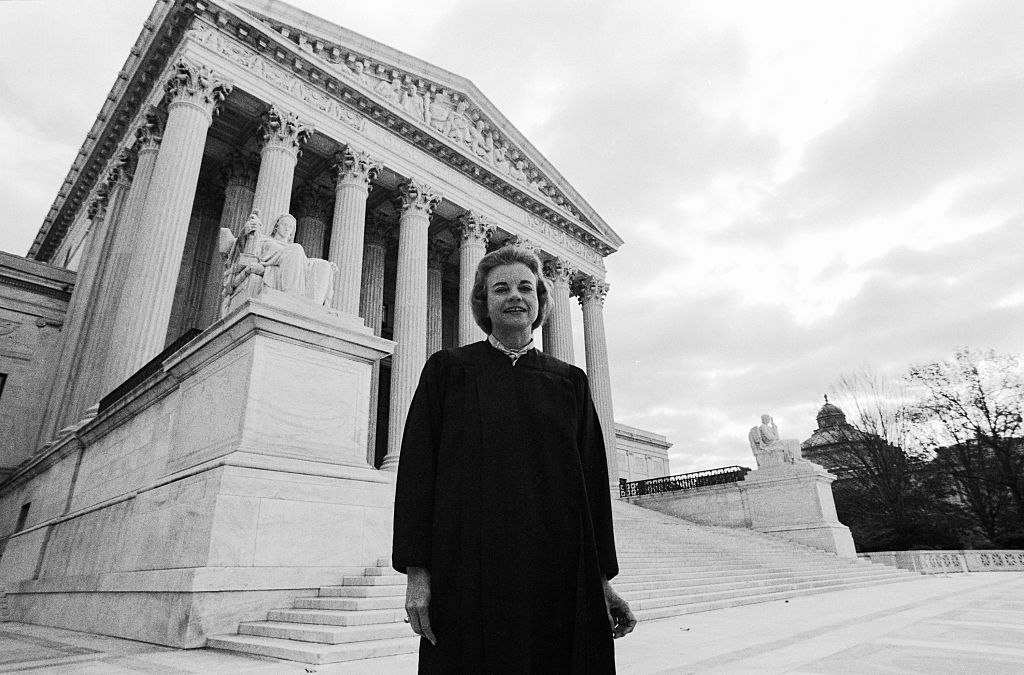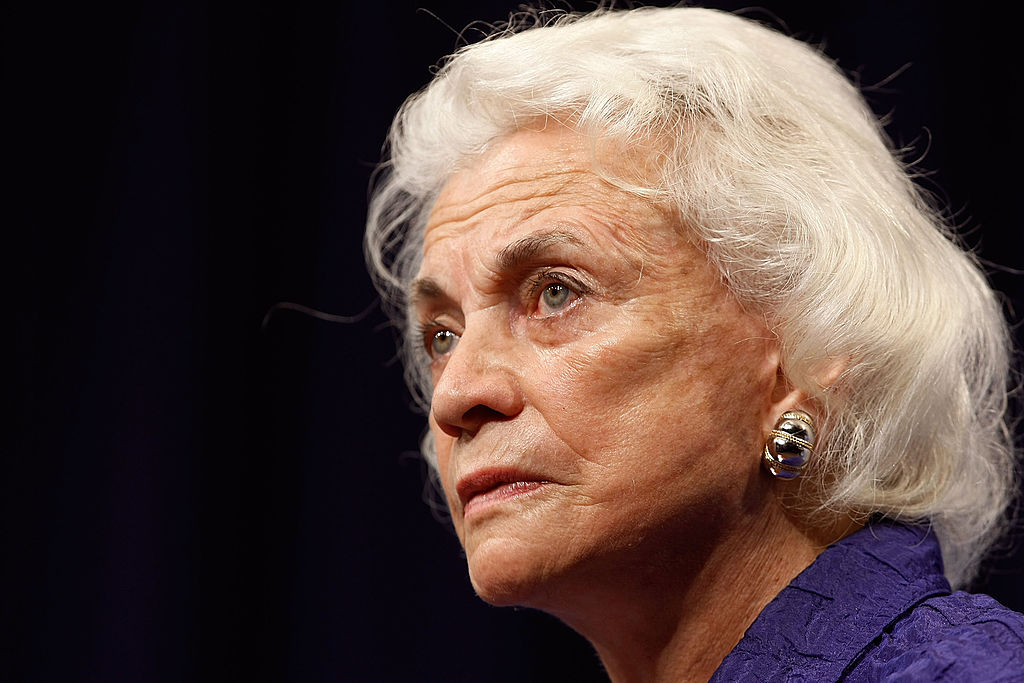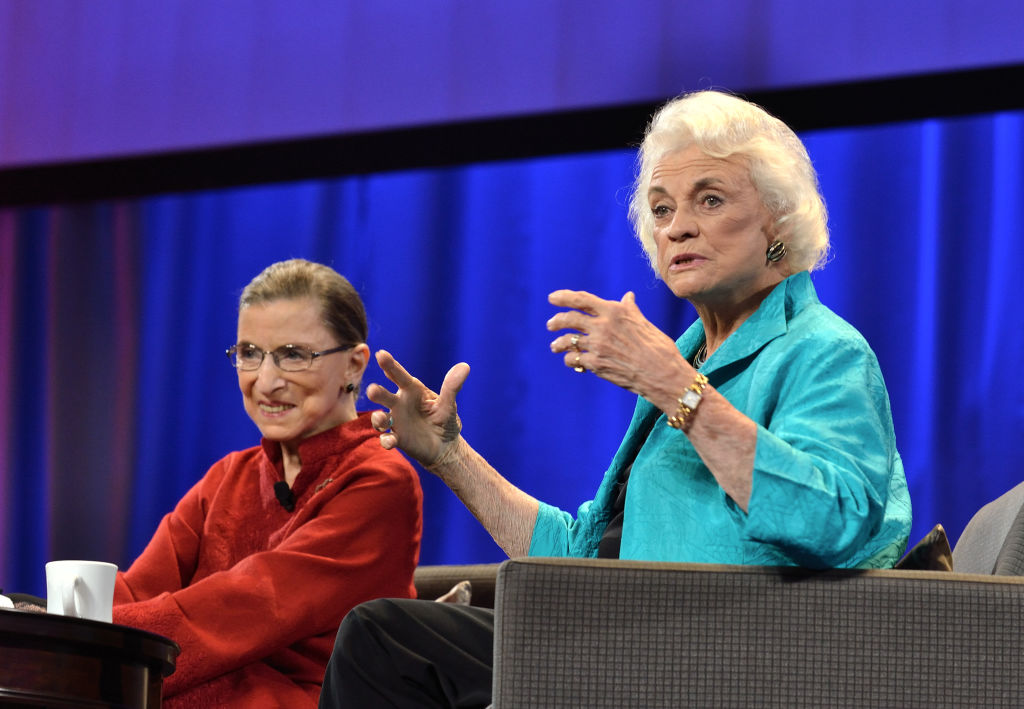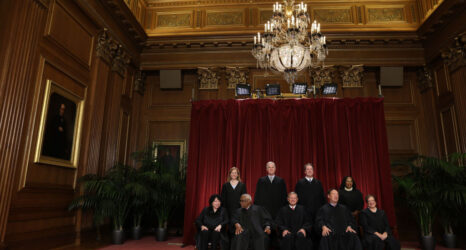Sandra Day O’Connor was a towering figure of the 20th century, a trailblazer, an independent voice, a cancer survivor, and the decisive vote on a narrowly divided court.

One hundred and ninety-one years after the first Supreme Court was convened, Sandra Day O’Connor smashed the glass ceiling and was sworn in as the first woman to become an associate justice and one of the most influential members in the history of the Court. She became the 102nd Supreme Court justice and served for 24 years. Five more women were to follow in her trail, with four women currently serving on the Court today.
For 12 years, she was the only women on the bench and the most powerful woman in the United States. At the time, the entire institution was designed for and by men—from the signs on the walls harking to “Mr. Justice,” to the lack of bathrooms and other facilities closed off to women (though she later inaugurated and regularly attended an aerobics class for women law clerks).
The road to her appointment as the first woman to serve on the Supreme Court was unconventional at best. After a 1980 women’s rights march at the Republican national convention in Detroit, then-presidential candidate Ronald Regan faced a serious gender gap during his campaign and needed a way the breakthrough to women voters. Sandra Day O’Connor, in her own words, told New York Times editors in 2008 her best guess:
NYT: “Why do you think you were chosen?”
O’CONNOR: “Well, when Ronald Reagan was running for president, he was eager to have some support from women and it was a little dicey for him. There was an abortion issue out there, so women were somewhat skeptical. And he said during the course of his campaign, if I get a chance to put a qualified woman on the Supreme Court, I would like to do that.”
Her appointment in 1981 by newly-elected Ronald Reagan came after his campaign pledge made headlines around the world. She was approved by the U.S. Senate with a vote of 99 to 0.
TIME magazine explained why so many approved of the choice, in a 1981 cover story about the nomination:
Other than on the far right, reaction to the nomination ranged from warm to ecstatic. Feminists generally were pleased.
Eleanor Smeal, president of the National Organization for Women, termed the choice “a major victory for women’s rights.”
Patricia Ireland, a Miami attorney, and a regional director of NOW, said she was “thrilled and excited” by the selection, adding: “Nine older men do not have the same perspective on issues like sex discrimination, reproductive rights or the issues that affect women’s rights directly.”
Declared former Texas Congresswoman Barbara Jordan, a black lawyer: “I congratulate the President. The Supreme Court was the last bastion of the male: a stale dark room that needed to be cracked open. I don’t know the lady, but if she’s a good lawyer and believes in the Constitution, she’ll be all right.”
Sandra Day was born in El Paso, Texas, in 1930. She married fellow law school student John Jay O’Connor in 1952 after receiving her undergraduate and law degrees from Stanford University, graduating in the top of her class. She was offered just one job in the private sector where a prospective employer asked her how well she typed and told her there might be work for her as a legal secretary. O’Connor eventually found employment as a deputy county attorney in San Mateo, Calif.—after she offered to work for no salary and without an office, sharing space with a secretary.
After various moves and raising a family, O’Connor was appointed to the Arizona state Senate in 1969. She won two reelection campaigns, during which she was selected as majority leader. At the time, O’Connor was the only woman in the United States to serve as a state majority leader—and no woman in the country had held such a high office in a state legislature.
After being elected judge of the Maricopa County Superior Court in 1979, O’Connor was appointed to the Arizona Court of Appeals, where she was serving when Reagan selected her for the Supreme Court.
In her first year on the Court, she received over 60,000 letters from the public—more than any other justice in history.
The Decisive Vote
After her death, Sandra Day O’Connor has been described as a towering figure of the 20th century, a trailblazer, an independent and influential voice, a cancer survivor, a pragmatist, a compromiser … and perhaps most importantly, the decisive vote on a narrowly divided court.

In many ways, O’Connor helped create a “golden age” of Supreme Court decisions for women, LGBTQ+, election reform, affirmative action and more. Many of these decisions have been reversed or seriously compromised by today’s right-wing, extremist Court majority, without regard to what O’Connor most brought to the Court: “our nation’s highest ideals of courage, integrity, patriotism and justice” (as described by House Speaker Emerita Nancy Pelosi).
O’Connor joined the Supreme Court eight years after the 1973 Roe v. Wade decision legalizing abortion nationwide. Her votes on abortion and LGBTQ+ cases, in particular, slowly and thoughtfully moved toward supporting the basic right to privacy, often casting the tie-breaking vote in various controversial cases.
In 1983, O’Connor’s first vote on abortion came in a case where the majority struck down a municipal ordinance in Akron, Ohio, that restricted women’s access to abortion by imposing waiting periods and counseling requirements. Her dissenting opinion then considered the restrictions to be valid and appeared to be attacking the principles of Roe v. Wade.
By 1992, she joined as co-author with Justices Anthony Kennedy and David Souter in a 5-4 decision reaffirming the constitutional right to abortion, in which the justices wrote that “it is settled now, as it was when the Court heard arguments in Roe v. Wade, that the Constitution places limits on a State’s right to interfere with a person’s most basic decision about family and parenthood … as well as bodily integrity.”
The decision in Planned Parenthood v. Casey struck down a Pennsylvania law that required a woman to notify her husband if she wanted to have an abortion and stated: “There are millions of women in this country who are the victims of regular physical and psychological abuse at the hands of their husbands. … Should these women become pregnant, they may have very good reasons for not wishing to inform their husbands of their decision to obtain an abortion.”
“Some of us as individuals find abortion offensive to our most basic principles of morality, but that can’t control our decision,” O’Connor said in court, reading a summary of the decision. “Our obligation is to define the liberty of all, not to mandate our own moral code.” This, a sentiment that is a direct opposite for a majority of the Supreme Court today.
With the Court now dominated by right-wing extremists, the Dobbs v. Jackson Women’s Health Organization decision in 2022 bulldozed away the constitutional right to abortion—abandoning almost 50 years of precedent and paving the way for state legislatures to attempt abortion bans.
In 1986, O’Connor sided with the conservative majority by voting to uphold a Georgia law that made sodomy illegal, the first LGBTQ+ case taken up by the Court. Two decades later, she took the other side in a similar case from Texas, arguing that the state’s “bare desire to harm” homosexuals violated the 14th Amendment’s Equal Protection Clause.
A decade later, in 2013, Justice O’Connor, then-retired, officiated the wedding of a same-sex couple at the Supreme Court.
She joined with the Court’s liberals in 2003 to preserve race-conscious admissions at the University of Michigan Law School, writing: “In the context of its individualized inquiry into the possible diversity contributions of all applicants, the Law School’s race-conscious admissions program does not unduly harm nonminority applicants.”
However, she added, “We expect that 25 years from now, the use of racial preferences will no longer be necessary to further the interest approved today.”
By 2023, the Court effectively ended race-conscious admission programs at colleges and universities across the country. In a decision divided along ideological lines, the 6-3 decision invalidated admissions programs at Harvard and the University of North Carolina.
O’Connor is blamed by some, and credited by others, for Republican George W. Bush winning the contested 2000 presidential election that was decided by the Supreme Court.
“It was a hard decision to make,” O’Connor told CNN in 2010 of her vote to block additional Florida ballot recounts sought by Al Gore, the Democratic nominee. “But I do know this: There were at least three separate recounts of the votes, the ballots, in the four counties where it was challenged. In not one of the recounts would the decision have changed. So, I don’t worry about it.”
With Justice John Paul Stevens, O’Connor joined a 2003 opinion upholding a landmark overhaul of campaign finance law: the McCain-Feingold Act. This decision was overruled by the 2010 case decision in Citizens United v. FEC overturning key provisions regarding political spending that has unleashed unprecedented campaign contributions by corporations.

O’Connor and Ginsburg, in the years they both were on the Court, “came out with the same ruling on cases involving women 95 percent of the time. However, you will see that often she rules for the woman litigant in the case but restricts the ruling so narrowly that in real life it doesn’t really help women a lot,” noted Linda Hirshman, author of the book Sisters in Law, about the relationship between O’Connor and Justice Ruth Bader Ginsburg who joined the Court as the second women associate justice.
Unlike Ginsburg, who devoted much of her life to advancing the rights of women for the ACLU and other groups, O’Connor faced a series of discriminatory and insulting experiences that helped mold her pragmatic thinking about social and cultural change.
Using Her Position to Raise Awareness and Make Change
In addition to her rulings on Supreme Court cases, O’Connor used her position at the Court to point out sexist conditions as well as to encourage women from all walks of life to break barriers and help other women.
In 1983, when a New York Times editorial mistakenly referred to the “nine men” on the Supreme Court, she responded with a letter to the editor, dubbing herself the “FWOTSC,” or the “first woman on the Supreme Court,” writing:
“According to the information available to me, and which I had assumed was generally available, for over two years now SCOTUS has not consisted of nine men. If you have any contradictory information, I would be grateful if you would forward it as I am sure the POTUS, the SCOTUS and the undersigned (the FWOTSC) would be most interested in seeing it.”
While serving on the Court, O’Connor was struck by breast cancer in 1988, and underwent a mastectomy. She barely took any time off—even after she lost her hair to chemotherapy. Rumors started to circulate that O’Connor would leave the Court, but she never missed a day of oral arguments and continued to regain her health and hair. Along with Betty Ford and other high-profile women with breast cancer, her story helped propel breast cancer awareness, medical research, and optional treatments. Only six years later, speaking to a group of cancer survivors, did she acknowledge how hard it had been.
In 1995, she and Ginsburg invited the top women’s college basketball team from the University of Connecticut to visit the Supreme Court. As reported in the New York Times:
“O’Connor led them into the courtroom and said, ‘I wanted to do this because what you’re doing is important.’ Then, looking over at Ginsburg, she said: ‘I can’t tell you how happy I was when she got to the court. It makes a night and day difference to have women on the bench.’
‘O’Connor then took the team to the Supreme Court gym. ‘This is the highest court in the nation,’ she said.
With coaching from Leslie, the team’s leading scorer, O’Connor banked in a shot. She slapped high fives with the team. The team members huddled at the foul line and chanted ‘U.S.A.’
The Times also made note:
“Although the two women neither looked nor sounded anything alike, male lawyers arguing before the court had challenges telling them apart. The frequent mix-ups, even by highly experienced members of the Supreme Court bar, inspired the two justices to appear at a reception for female judges sporting complementary T-shirts.
‘I’m Ruth, not Sandra,’ read one shirt. ‘I’m Sandra, not Ruth,’ read the other.
In a short letter to President George W. Bush in 2005, O’Connor announced her decision to step down from the Court. “I will leave it with enormous respect for the integrity of the Court and its role under our Constitutional structure,” she wrote.
Her husband had been diagnosed with Alzheimer’s and she wanted to share what time they had together; he later died in 2009. She had hoped another woman would be named upon her vacancy. Instead, Bush named Justice Samuel Alito, the author of the Dobbs decision on abortion.
After O’Connor’s retirement from the Court, she founded and led iCivics, the nation’s leading civics education platform, and expressed hope that new leaders would “make civics learning and civic engagement a reality for all.” O’Connor didn’t hesitate to make her voice heard through speeches, books, at conferences and meetings and in interviews, some of which she asked to remain private until her death.
In 2018, O’Connor ignited another public conversation, one that had often been a taboo private subject, when facing “the beginning stages of dementia, probably Alzheimer’s disease.” She released a public letter announcing her intention to withdraw from public life.
“How fortunate I feel to be an American and to have been presented with the remarkable opportunities available to the citizens of our country. As a young cowgirl from the Arizona desert, I never could have imagined that one day I would become the first woman justice on the U.S. Supreme Court. … I hope that I have inspired young people about civic engagement and helped pave the pathway for women who may have faced obstacles pursuing their careers.”
Although all of her Court decisions did not support a progressive agenda, she was a pragmatic conservative-leaning justice who blazed the trail for other women to advance as lawyers, in the Courts and as top elected officials.
Sandra Day O’Connor will be missed, but her contributions and her spirit will live on.
Here are just a few of the statements about Justice O’Connor:
President Joe Biden
Justice Sandra Day O’Connor was an American icon, the first woman on our nation’s highest court. She spent her career committed to the stable center, pragmatic and in search of common ground. I did not agree with all of her opinions, but I admired her decency and unwavering devotion to the facts, to our country, to active citizenship and the common good… Unrelenting in her interrogations of attorneys before the Court, she was willing to learn and to change, open to the experience of fellow Americans and always conscious of the law’s real impact on their lives….As a U.S. Senator on the Judiciary Committee, I remember the hope surrounding her historic nomination to the Supreme Court. The Senate voted 99-0 in her favor, proof that our nation can come together to move history forward.
Former President Barack Obama
When a young Sandra Day graduated from Stanford Law School near the top of her class—in two years instead of the usual three—he was offered. just one job in the private sector. Her prospective employer asked her how well, she typed and told her there might be work for her as a legal secretary. Fortunately for us, she set her sights a little higher—becoming the first woman to serve as a U.S. Supreme Court justice. As a judge and Arizona legislator, a cancer survivor and child of the Texas plains, Sandra Day O’Connor was like the pilgrim in the poem she sometimes quoted—forging a new path and building a bridge behind her for all young women to follow.
Senate Majority Leader Chuck Schumer
With every case she oversaw, and every opinion she authored, Justice O’Connor carried out a historic role with integrity and distinction. She moved our country forward in so many ways: protecting women’s rights, protecting clean air, protecting voting rights, fighting discrimination. I can’t help but reflect on her calm and steady presence on the court, even in the most tumultuous of times and the most divisive of cases. That presence was so needed during her tenure, and she will be sorely missed.
Republican U.S. Senator Susan Collins
The passing of Justice Sandra Day O’Connor reminds all of us of what an extraordinary woman and justice she was. As the first woman to serve on the Supreme Court, she was a trailblazer and a role model for girls and women… She exemplified excellence in public service.
U.S. House of Representatives Speaker Emerita Nancy Pelosi
Justice O’Connor earned her place in history as the first woman ever to sit on the Supreme Court, where she was always an independent and influential voice. Beyond shattering a glass ceiling, her service on the bench reflected our nation’s highest ideals: courage, integrity, patriotism and justice.
U.S. Supreme Court Justice Elena Kagan
I remember the day Justice O’Connor was nominated to the court as though it just happened. As a young woman looking forward to law school, I thought the event momentous and inspirational. But I couldn’t have known then how momentous and inspirational that new nominee’s tenure on the court would turn out to be.
U.S. Supreme Court Justice Ketanji Brown Jackson
I had the honor of observing Justice O’Connor at work during my service as a law clerk for Justice Breyer. Full of grace and grit, she was a marvel to watch and learn from during oral argument. In addition, as the first female Justice, Justice O’Connor helped pave the road on which other jurists, including me, now walk. Her story has inspired generations of lawyers and generations of Americans, and her commitment to justice and to the rule of law continues to serve as a model to us all.
Angela Onwuachi-Willig, dean of Boston University School of Law
We all owe a debt of gratitude to Justice Sandra Day O’Connor for all the barriers she helped break down for women in the legal profession, and critically, on the highest court in our nation. I always feel a little stunned when I look at pictures of the Supreme Court when Justice O’Connor was the sole female justice, for two reasons. First, looking at those photos makes me pause and appreciate how lucky I am to have the opportunity to work in spaces with other women and women of color attorneys, and it fortifies my appreciation for Justice O’Connor, who really blazed a trail for all of us. Second, it makes me realize how accustomed we have all become to seeing many women on the Supreme Court. That progress would not have happened without Justice O’Connor.
Evan Thomas, author of the official biography, First: Sandra Day O’Connor
The law was a male thing. The Supreme Court was a male place. Merely her presence there as a woman changed everything. … She was a feminist, but she didn’t call herself that. … She knew that to get along with these men who were waiting for her to fail, she had to be careful, but at the same time tough and strong. It was a hard balance to strike, but she did.
Eugene Volokh, professor at UCLA Law School and former law clerk to O’Connor
She had one of the great careers in American law: Not only as the first woman Supreme Court justice, but also as a successful political leader with the ability to bring people together. Through it all, she always acted not just with resolve and honor, but with grace and kindness. She was a great judge, and a great American.
Justin Driver, professor at Yale Law School and former law clerk to O’Connor
Today, we lost a towering, trailblazing jurist who dramatically improved our nation. Justice O’Connor viewed constitutional law as an incremental, stabilizing force in American society, and she was therefore extremely hesitant about overturning precedents because such decisions jolted the legal system. While she will justifiably be remembered as the most powerful woman of her era, she consistently comported herself with great judicial modesty. She was quite simply a national treasure.
Rakim Brooks, president at Alliance for Justice
We are saddened to learn of the passing of Justice Sandra Day O’Connor, a true trailblazer who changed the course for women judges and justices. While we may not have agreed with every decision she authored, Justice O’Connor stood for a kind of justice that we admire: a true free thinker who sought compromise and emphasized fidelity to the rule of law. Today’s justices would be wise to emulate her example and refuse to bow to petty partisan interests. What better way to honor Justice O’Connor’s legacy and commitment to the founding principle of an independent judiciary?
Heather Cox Richardson, historian and author of “Letters from an American”
O’Connor was known as a pragmatist who paid attention to the real-world consequences of the court’s decisions and who was willing to rethink her positions. Traditionally, this understanding of how court decisions affect lives has come from justices who have held elective office before their elevation, and O’Connor fit the bill: she served in the Arizona state senate for 5 years, eventually becoming majority leader. Since she stepped down in 2006, there have been no judges on the court with that elective experience, and the court has swung hard to the right.
Ruth Marcus, Washington Post associate editor
I’ve covered 15 Supreme Court nominations—plus several that blew up along the way—and I can now safely say O’Connor wasn’t just the right woman for the job. She was the right justice for that moment, and one whose approach to the law—more infused with common sense than driven by ideology—is sorely missing in this one.
Up next:
U.S. democracy is at a dangerous inflection point—from the demise of abortion rights, to a lack of pay equity and parental leave, to skyrocketing maternal mortality, and attacks on trans health. Left unchecked, these crises will lead to wider gaps in political participation and representation. For 50 years, Ms. has been forging feminist journalism—reporting, rebelling and truth-telling from the front-lines, championing the Equal Rights Amendment, and centering the stories of those most impacted. With all that’s at stake for equality, we are redoubling our commitment for the next 50 years. In turn, we need your help, Support Ms. today with a donation—any amount that is meaningful to you. For as little as $5 each month, you’ll receive the print magazine along with our e-newsletters, action alerts, and invitations to Ms. Studios events and podcasts. We are grateful for your loyalty and ferocity.





